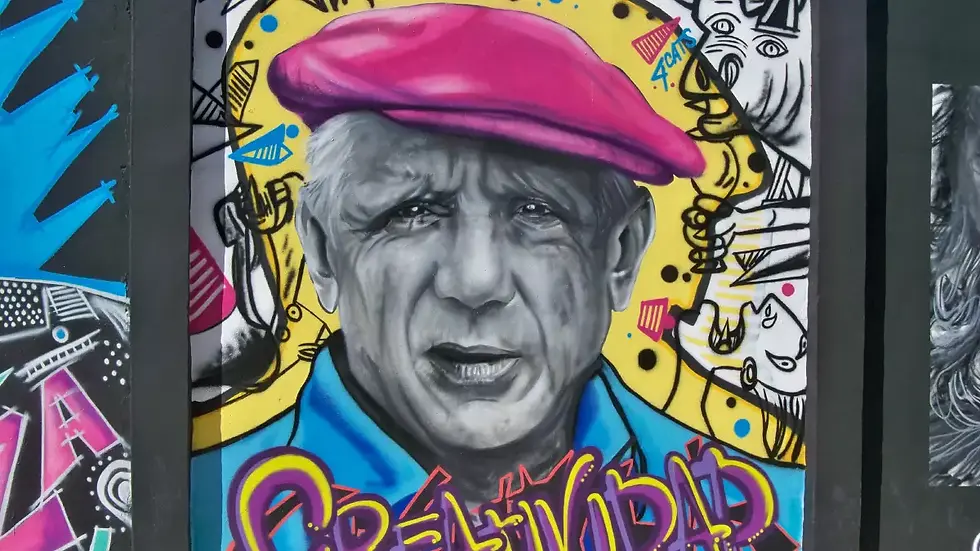An Afternoon in Malaga
- Shehan
- Jul 28, 2022
- 5 min read
Updated: Jun 24
Squabbling with spouse in sunny Spain.
What brought us to the southern coast of Spain for an afternoon? A Viking cruise ship, on the tailwind of its second week from Bergen. For first-time cruisers, it is around the 2-week mark that cabin fever sets in. Tempers begin fraying, buffets become treadmills, and each port starts to merge into the last.
So we came to Malaga, one of the oldest cities in the world, bringing only our sun hats and sour moods. We knew little of this Andalusian port city, a crossroads between Europe and Africa, between history, culture, trade and empires. As it turned out, curiosity is the cure for ennui, and Malaga had a menu of stories, textures and flavours as rich and varied as the tapas we savoured along the way. An afternoon later, we returned to our floating hotel with a headful of colours, shapes and histories.
The first mood enhancer was the sunshine, which made the sandy shores of the Playa dela Margueta sparkle and lit up the old town of Malaga and its many marvels. According to our tour guide, sunshine is available 320 days a year, and the surrounding Montes de Malaga mountain range creates this microclimate, tempered by breezes from the Alboran sea.
By the time we set foot on the paved streets and gaped at the architecture, hands were held, smiles were visible and sullen moods had been left on the shores where traders, pirates, explorers and conquerors had once set foot. The buildings reflected the colours of the earth: russet browns, sandy yellows, mountain greys and bamboo beiges. Across arches, stone walls, turrets, minarets and red-brick facades there unfurled a myriad of civilisations that had each left fingerprints here scattered across three millennia.
The roll call of conquerors is long. First the Phoenicians, then the Greeks, Carthaginians and Romans. Then the Vandals, the Visigoths, and the Byzantines. Then eight centuries of Moor rule which fell to Catholic conquest in 1487. A Napoleonic invasion and a twentieth century civil war later, we have modern Malaga, where the caresses of many cultures are visible and palpable.
There are churches built on mosques that were built on temples. There are Moor castles, Roman amphitheaters, Baroque cathedrals, a Jewish quarter and a French Pompidou centre. You can find beauty and soul in how the streets curve, how the shop windows glisten and when the courtyards come alive.
These days, the invaders are mostly tourists like us who are shipped in for the day to loot our way through street markets, artisanal stalls and the malls by the beach, or to help ourselves to paella and wine while the natives siesta. But how much to conquer in a mere afternoon? Our tour group is led up a hill to the foot of the Gibralfaro mountain, where a medieval Moor fortress, that we have neither the time nor the legs to conquer, looks down on us.

The view is enchanting and stretches from the ocean and manicured beach to the mountains over our shoulders via an iconic clocktower and a colourful square. ‘The air is so beautiful it is almost thought,’ mused poet Ferdinand Garcia Lorca on his many stays in Malaga. Our guide identifies by rooftop the old justice court, the city hall, the university, the bull-ring, the fountain and the obelisk, amidst orange trees. Jacaranda and bouquets of bourganvillea.
He tells us that Malaga is also now a tech hub with entrepreneurs coming in on hi-speed trains and hobnobbing with the jet set at Marbella and along the Costa Del Sol coastline. He wisely avoids discussions on bull-fighting and Christopher Columbus, though we suspect he is a fan of both. And then armed with Iberian pork, fresh sour dough and goat’s cheese, we are given our first mission for the day. To meet Pablo Picasso.
On our walk to the promenade, where Malaga’s favourite son played and painted, we are introduced to a statue of Picasso and an almond seller who is the great artist’s doppelganger. We are shown the exterior of actor Antonio Banderas’ apartment, in case we thought Pablo was the only global celebrity to be born here.
The Museo Picasso is a collection of treasures: Rare biographical memorabilia and 204 artworks across Picasso’s journey from early Blue and Rose periods to Cubism, Surrealism and beyond. In this mix of lines, colours, patterns and shapes, we see the evolution of the thinker and the artist. Even minor works and abandoned sketches display a gifted hand and an expanding vision. There is a reproduction of the artist’s studio, letters from his youth, and elements and ideas that would surface in his later masterpieces like Guernica and Les Demoiselles d’Avignon.

Next was the Alcazaba Palace, an 11th century Moor Castilla which was next to a 1st century Roman Amphitheatre. For those like us, who missed out on a tour of Granada’s magnificent Alhambra (Pro tip: Please book months in advance), the Alcazaba was a joyous surprise with its flower gardens, horse-shoe archways, brick towers and intricate adornments from the Nazari dynasty. Below it was the Teatro Romano which dates to Augustan times and was rediscovered in the 1950s by construction workers.
There are contemporary live performances in this 2000-year-old Roman Amphitheatre and at night it lights up in the shadows of the Alcazaba. But for this afternoon, we simply contemplate using a device invented in 2007 to photograph a fortress built in 1036 while seated at a theatre constructed before 100 AD. We discuss this further at the café on the hill over glasses of mosca grape wine bottled in 2016.
The Cathedral de Malaga is where the tour ends, but what a finale. An unfinished symphony crafted by five architects over 200 years, its intricate façade is as immersive as any Picasso, though it uses the shapes and textures of the Baroque, the Gothic, the Rococo with some hints of Mannersim. Nicknamed La Manquita or one-armed lady for its unfinished final tower, it’s worth a ticket to the top of the cathedral for one last panorama of this scenic city.
With a few hours left, there isn’t time for the Atarazanas Food Market or a harbour stroll along Muelle Uno or even the Automobile and Fashion museums which would have been interesting sorbets to all the antiquity that our senses had feasted on. But we instead enjoy the street music in the air and the platter of accents and languages, not just from tourists but from the friendly locals. ‘We live in a beautiful world,’ says the Scandinavian lady running a flamenco shop to a conveyor belt of day tourists. ‘We welcome one another.’ Malaga evidently continues to be a crossroads of cosmopolitan people and enterprising ideas.
There’s a handful of Michelin-star restaurants, an English cemetery that the guidebook insists we see and La Malagueta, ‘where fishermen live in condos’ according to our guide, but that will have to wait till the next ship brings us in. We content ourselves with plates of shrimp, sardines, chick pea in olive oil, flavours of the earth and sea. On the last bus to the port, with cameras, bellies and shopping bags full, we look back on this city of many pasts and presents, and, old arguments forgotten, prepare to set sail once more.












Comments